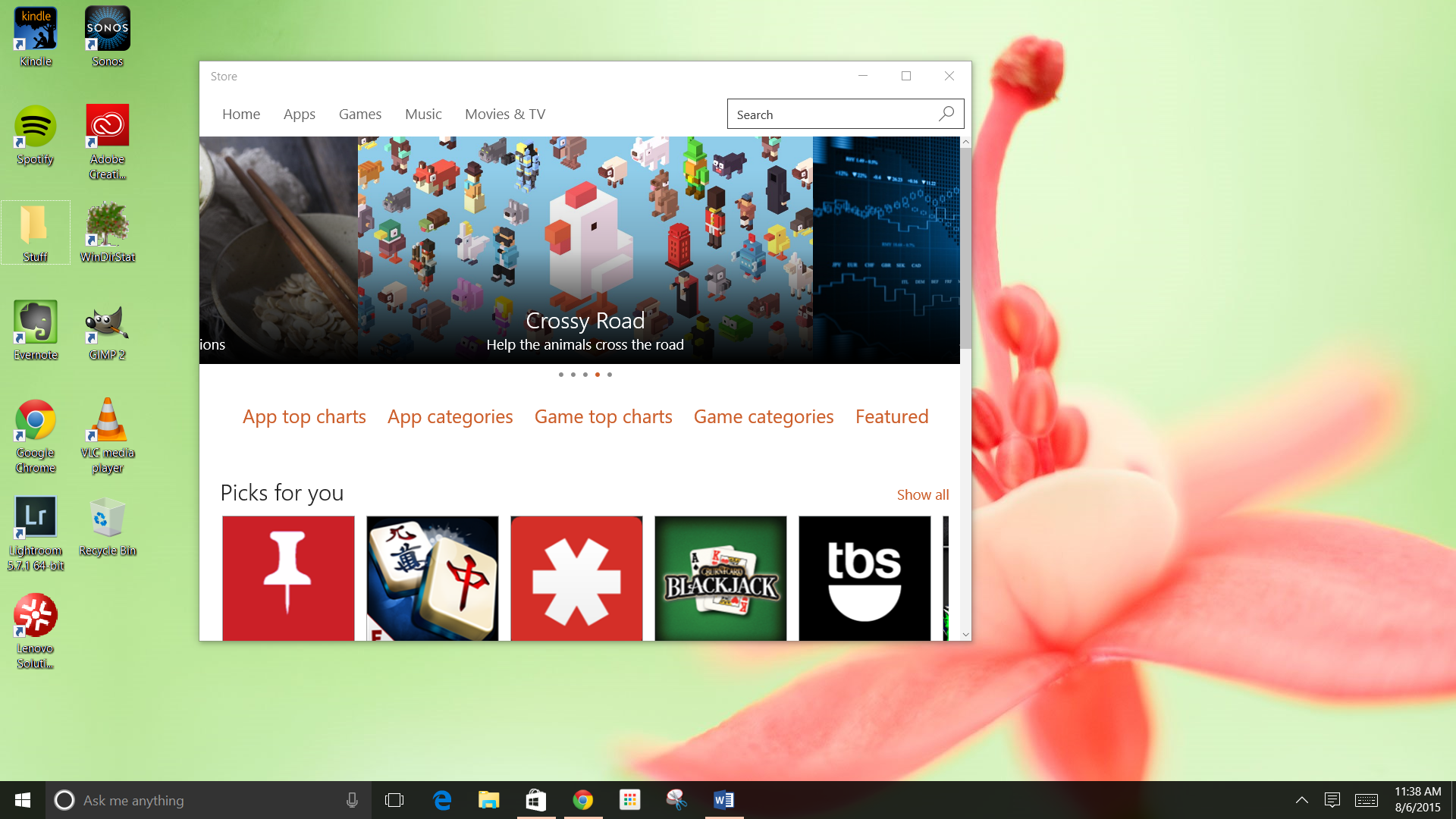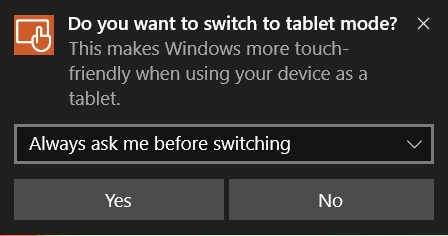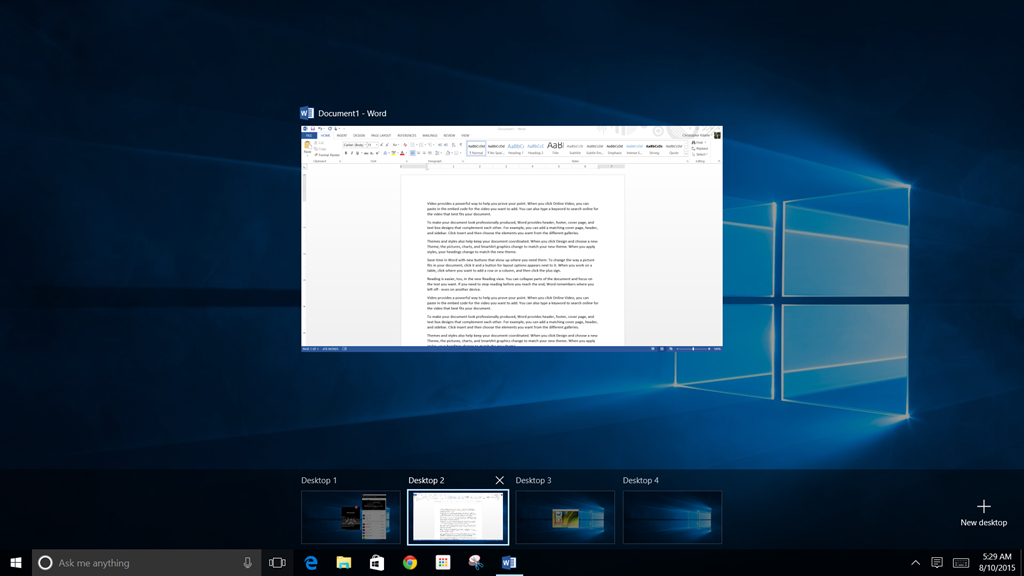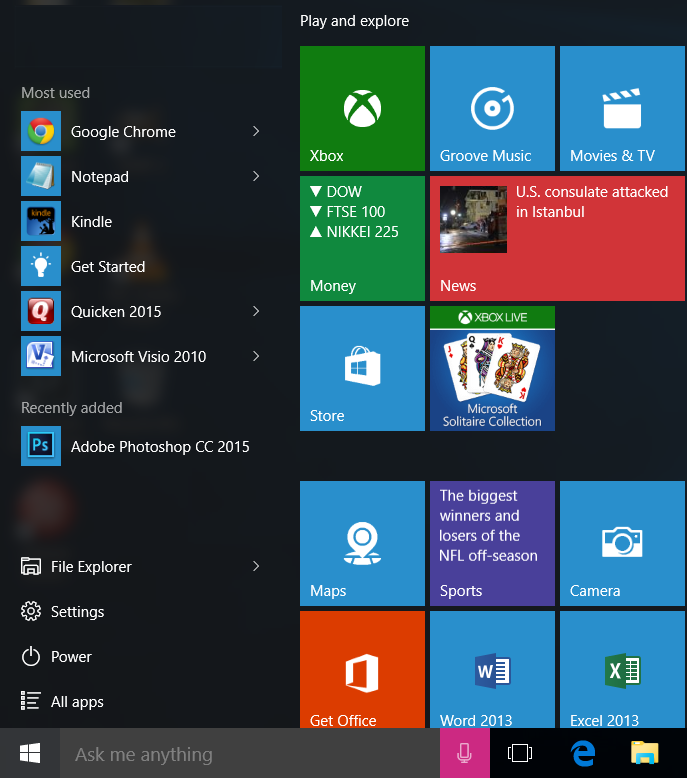First Impressions of Windows 10
Just shy of a week ago, a few days after Microsoft released Windows 10 to the public, I downloaded and installed it. I had run some pre-release versions in Virtual Machines and on a test laptop over the last few months, but this was my first venture into upgrading with my everyday machine, and the one I'm writing from now. With a single exception, which I'll mention below, the upgrade went completely smoothly. I didn't lose any data, and all of my applications continue to function perfectly. In the post below, I'm going to discuss how I upgraded, and seven of the things that have come up as "first impressions". Specifically, things that have changed since Windows 8.1.
How I Upgraded
I was really hoping to take advantage of the "Get Windows 10" pop-up that I first saw sometime back in early June. One of the Windows Updates that came down for earlier versions of Windows said it would notify me when my system was ready to upgrade. I really expected that on June 29th I would get a popup to start the installation, but nothing happened. I gave it a few days and it still said I wasn't ready. I suspect that Microsoft was releasing in batches, both as a way to limit the inbound calls to their support center, as well as the load on whatever servers are hosting the download content. Given how much data center space that Microsoft has under its control, my guess would be more the former.
When I didn't want to wait any longer, a quick Google search revealed the Windows 10 Download page. Unlike most other of their download pages, this one is actually pretty clean. Some basic instructions, and a 32-bit and 64-bit download link. The download is about 20MB, and is used as a fetcher application to get the rest of the media from the Microsoft download servers and start the upgrade. You can ignore the bit about the USB or blank DVD if you're going to upgrade in place. The upgrade took about 2 hours, which I was very surprised at. It's possible that a lot of this time was downloading, and perhaps the pipes are a bit overloaded this week, but I was none-the-less surprised, since I've done full installs of Windows 8 (from ISO) in less than half that amount of time.
Once the installation was complete, I took a few minutes first to make sure I hadn't lost any data (it was all safe), and then to check out the applications I use the most to make sure they would work OK. Those included: Quicken 2015 R8, Google Chrome, Microsoft Word & Excel (Office 365 Versions), and Visio 2010. Everything worked great. Shortly after the upgrade, in less than an hour, I got alerts from both Java and Adobe Creative Cloud that upgrades were required. The Adobe CC update said it was specifically Windows 10 updates, but Java was a bit more generic, so that might have just been strange timing.
The only issue I've had so far has been that my microphone is not being recognized by Windows 10, which is strange since it's a pretty "dumb device", so I'll have to do some more digging. Unfortunately, this prevented me from really testing out Cortana's voice recognition.
Metro Applications in the Desktop View

I can usually, over time, rationalize a lot of Microsoft's decisions on why they go one direction or another. Often I'll realize that something was done for the greater good, or to make enterprise customers happy. Even when I don't like something, I'll realize that there was purpose behind it. The metro view in Windows 8 was not one of those times. From going to a lot of conferences and hearing a lot of Microsoft and non-Microsoft people speak on Metro, it seemed like Microsoft just kind of assumed that everything was going mobile/tablet - that everyone wanted "touch everything", and that we wanted our phone experience on our laptop. Judging by the outcry at TechEd, the plethora of posts online, and the fact that they've "undone" (kind of) this in Windows 10 means I guess they were wrong. There are still the new Metro style applications, but there is no longer a "Metro View vs. Desktop View", at least for regular laptop users.
When not in tablet mode (which I'll discuss next), our Start Menu has returned to opening on the desktop instead of replacing the desktop, and Metro apps open just like any other application. In the screen shot here, you can see that the Store application opens right on top of my desktop and I can move in and out of it just like any other application. I haven't played with them enough to know if there are limitations to them existing in this "old world", but basic usage and moving them around seems to work fine.
Tablet Switching

While this won't apply to everyone, the number of convertible laptops/tablets is growing. I'm using a Lenovo ThinkPad Yoga 15, which functions as a normal laptop when positioned like one, but the screen can be folded back so that I can carry it around like a tablet. When I flip my screen around, Windows 10 asks me if I'd like to enter Tablet Mode. On my Yoga, this appears to happen after the screen moves just beyond flat with the keyboard.
While in Tablet Mode, your Start Menu is once again replaced with the Metro View, with some key differences from Windows 8. If you look at the screen shot, you'll notice that there is still a task bar running at the bottom of the screen. This allows you to still see the date and time, view the notification area, and switch back and forth from your desktop. What you won't see, is the cluttered All Applications view that was normally at the bottom of this window. Instead, you can click that details button in the lower left corner of the screen to get the same alphabetized list of installed applications that you see on your normal start menu. Unfortunately, running applications of either variety do not go down on the task bar for easy switching - I'd like to see Microsoft change this in a new release - just because I'm on a tablet doesn't mean I don't want an easy touch or click option for moving between applications. Instead, I have to click on the Task View button (which I'll discuss below) to move between open apps.
Task View and Multiple Desktops

Switching between open applications can be done in all the same was as previous versions of Windows. Clicking on the applications on the task bar continues to work, as does Alt+Tab, and Windows+Tab, although window switching using the keyboard shortcuts does get a little face lift. Alt-Tabbing between windows shows a much larger version of the application you're switching to than I can remember from earlier versions of Windows, and you can still tab your way through them all, click on of of the windows with your mouse (or finger) while holding in the alt key, and Alt-Shift-Tab to move backwards through the list. Unfortunately I'm not fast enough to capture this in a screen shot, and I don't have Windows 10 setup in a virtual machine where I could capture it in the guest system, either. So you'll just have to use your imagination for now... or upgrade.
Windows-Tab, however, now brings up the new "Task View" window (see screenshot to the left, click to make it larger). This window, which doesn't require you to hold down any keys to remain open, allows you now only to see all of the applications you have open, but also allows you to create multiple desktops to organize the applications you have open. While this feature does come a decade or more too late for Linux users, who have enjoyed this benefit for quite some time, it is a welcome change for me in Windows 10. At home, I'll use this as an easy way to separate my school applications from my home/finance applications, since I like to leave my class Visio diagrams, notes, webpages, etc. open most of the time for easy review when I have a few minutes. At work, I'll use this to break out different work streams that I tend to multitask on through out the day - perhaps a few RDP sessions open on one desktop in the background for quick access while I have uncluttered desktop open to work on a document that desperately needs my attention. As you can see in the screenshot, which I'll admit I doctored just for this post, I have four desktops running, with various applications running on the first three, and the fourth one currently blank. While I'm sure there is a limit to the number of desktops that I haven't been bothered to look up yet, I was able to have 20 running at once with no issue.
Start Menu

Thank. You. Microsoft. At least while not in Tablet View, our old start menu has been brought back from the dead, dusted off, and improved upon. As you can see in the screenshot, which you can click to enlarge, we have a menu that once again lays over the desktop instead of replacing it. What the image doesn't really convey, however, is that all of our new tiles are now live, just like with Windows 8. I'm not sure I'll leave the start menu open long enough to scroll through sports scores, or see all the latest news, but I'll admit it's been kind of nice to see the weather at a quick glance as I go to launch an application.
What has been removed from the Start Menu is the search bar. What I really liked about Windows 7 and 8 was that I could hit the Start Menu and then immediately start typing what I wanted to open. It would find anything I had installed, even if it didn't have a start menu icon. It would even find Office documents, images, etc. that I had on my system for easy access. This appears to have been replaced by Cortana (more on her below), and seems - so far - to work just as well.
It's worth noting that when running on a tablet, or on my Yoga in tablet mode, the Start Menu is once again replaced by the full screen view of tiles, just like in Windows 8. Earlier versions of Windows 10, before the public release, had an easy way to turn this off in the task bar properties so that even tablets could use the regular start menu, but I haven't seen this option yet - and I probably wouldn't change it anyway.
Notification Area & Action Center
I rather like the changes that come with the Notification Area in Windows 10. This is the space down in the lower right corner of the screen that typically shows your date and time, and where applications can run and pop up messages as they need your attention. While not much seems to have changed in the space for running applications, the newly designed Action Center allows you to see a list of things that require your attention, and also modify a number of Windows 10 settings very quickly, including things like the network you're attached to, if you're running in Tablet Mode or not, your brightness, and some new features like Airplane Mode and Battery Saver.
Microsoft Edge
At a time when I'm deep into an Internet Explorer 11 upgrade project, I was very eager to see what came with Microsoft Edge, the replacement for Internet Explorer. Microsoft desperately needed a rebranding for IE given its history and hatred within a lot of the tech circles. With Edge, we got more than a new name, but a brand new browser that I believe isn't based on IE at all. That said, my opinion is: Eh. The look and feel of it is that of a Metro application, you can kind of just tell it doesn't fit in with the other applications you're using.
I haven't used it long enough to know how well it'll support the pages that I frequent, and to be honest, muscle memory has me opening up Chrome every time I visit a page, anyway. It was poor experiences and poor plug-in support that got me from IE 8 to Firefox, it was poor performance that eventually moved me from Firefox to Chrome, and Google is going to have to really screw something up in Chrome for me to want to switch again. What we probably have in Edge is now just another browser for developers to have to deal with, and Enterprises to need to worry about support for, at least for the next few years until IE dies out officially.
Cortana

Last, but certainly not least, comes Cortana. Cortana and I first met back in 2001 when she was the synthetic intelligence character for Halo, and today she is Microsoft's answer for Apple's Siri. In Windows 10, Cortana replaces traditional search as well as taking on the role of your personal assistant. Like Siri, you can ask Cortana to remind you do to things, to search the web for you, or to find a file that you have saved on your system. I'm sure many of us will spend the next few weeks trying to find all of Cortana's easter eggs. but in the mean time, I've been testing her out using Wolfram-Alpha style questions, and she seems to do quite well, and is very fast. For example, I've just learned by asking "How tall is the Empire State Building" that the ESB is 1,454 feet fall when you include the antenna.
What I don't like, however, was that I wasn't able to copy & paste that answer as text, making it difficult to reference without retyping. I've also gotten some significant use over the last week using Cortana as a calculator, which you can see in the included screen shot, however once again, the inability to copy and paste is a huge oversight on Microsoft's part.
Conclusion ...
So, was it worth the upgrade? Absolutely. I get my old Start Menu back, a new notification area, and multiple desktops built right into the OS, and besides the microphone issue, which I'm sure I'll find a resolution for, I've had no problems at all. Put on top of that a relatively easy (although lengthy) upgrade process with no loss of data or application usage and you've got a happy user here.
1 comment
Nicely done.